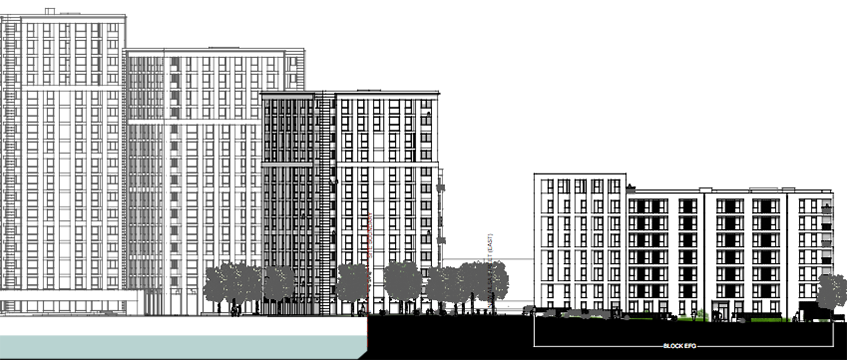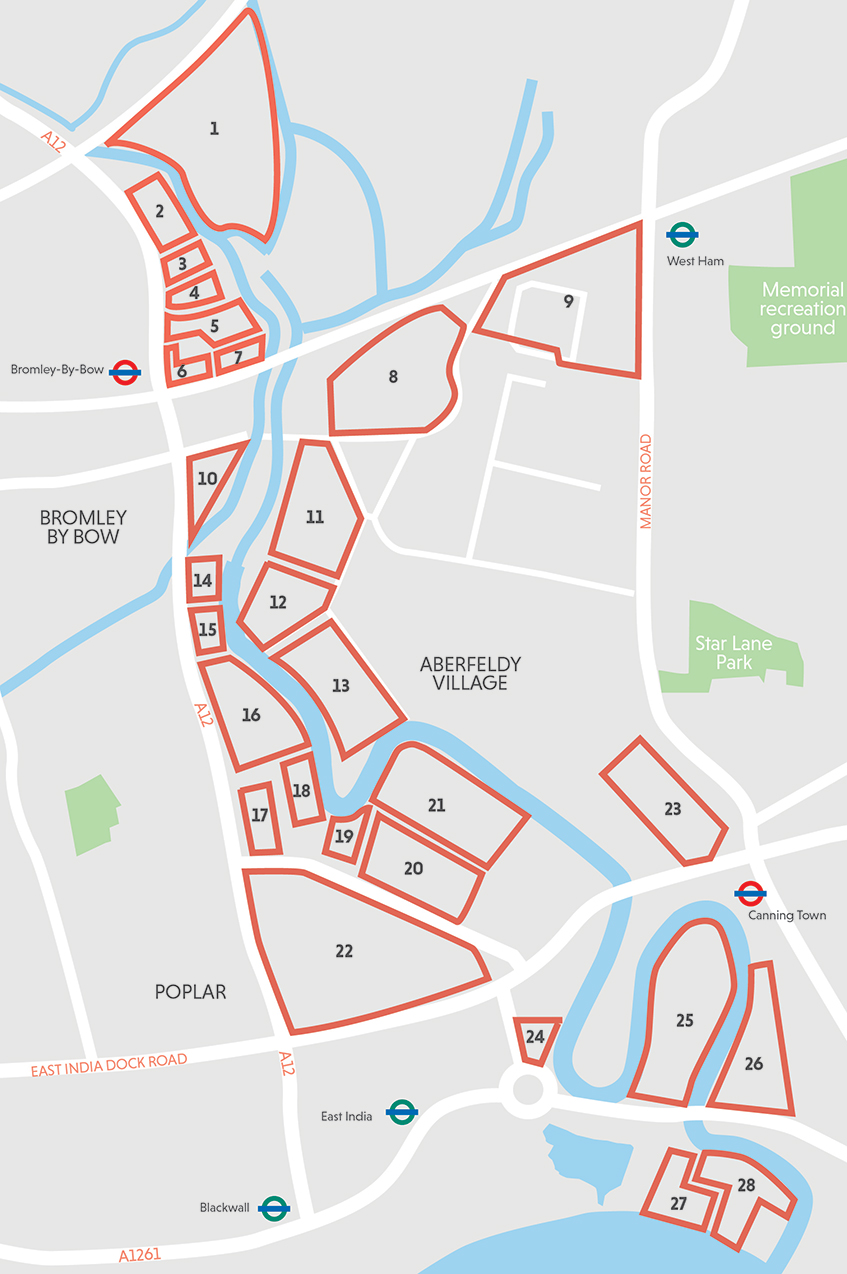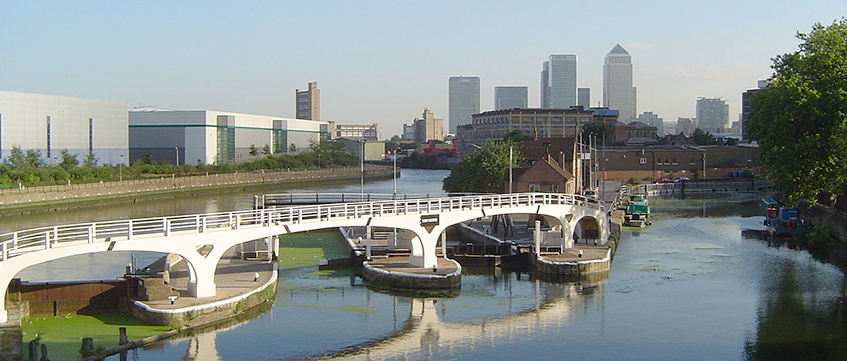Three months ago the world’s largest residential developer chose London’s Bow Creek for its landfall in the UK.
It was a surprising choice for Country Garden, more used to dazzling schemes in Australia, Malaysia and Hong Kong, or mammoth developments in its native China.
The unassuming stretch of tidal river in east London does not have the same panache and glamour as other spots of London development like Vauxhall, Canary Wharf and the Old Kent Road.
But looking behind the disused offices and open storage land that currently occupies its banks, Bow Creek is far from the sleepy backwater it first appears.
It has quietly attracted the likes of British Land, Berkeley and Ikea’s old development arm Vastint, and could see 20,000 homes built along a 2.5-mile stretch of river, creating London’s next development hotspot.
So could this little-known area of east London be one to watch?
Where and what is it?
The creek, which runs parallel to the A12, forms the natural boundary between Tower Hamlets and Newham. Despite being on the edge of Zone 2, it has escaped the massive redevelopment seen in Stratford to the north and Canning Town to the south-east over the past 10 years.
It is a fascinating glimpse into east London’s industrial past and subsequent decline, and how stretched local authorities in the 1980s tried to deal with this. Dotted among the dumping grounds and disused buildings are beautifully designed old warehouses, mills and even a lighthouse.
But its industrial past means plots are large and in relatively simple and singular ownership, while land values are comparably cheap, and that has attracted investment and construction. Naturally, the northern end closest to Stratford and the southern end closest to the Thames have seen the early movement in terms of development.
At the northern boundary sits Vastint, owned by the Interogo Foundation which also owns Ikea, building 1,400 homes at Sugar House Island. On the other side of the creek sits Southern Housing Group’s 410 homes at Bow River Village. A mile and a half to the South as the crow flies, further down its twisting banks, Ballymore and EcoWorld are putting the finishing touches to 1,400 homes at City Island.
More units are planned at the southern end, the easiest part of the Creek to develop owing to its proximity to the Thames and Canary Wharf, by both Ballymore and Regal London. Goodluck Hope and Orchard Wharf will have 800 homes apiece.
EG research now counts around 18 sites on the banks of the river along this 2.5-mile stretch, but only two residential schemes completed before 2016.
Ailsa Wharf
What is in between the northern and southern ends is perhaps most interesting: 15 sites with various owners that could accommodate more than 15,000 homes, at the centre of which sits Country Garden’s Ailsa Wharf.
For those not au fait with the company, the Hong Kong-listed firm, headquartered in Foshun, mainland China, achieved contracted sales of RMB550.8bn (£62.3bn) last year and profits of RMB58.79bn. In mainland China it has 1,468 active projects in 768 towns, 220 cities and 30 provinces. By comparison, Barratt, the UK’s largest housebuilder, had £2.7bn of contracted sales and profit of £765m in its annual results to June 2017.
It has been looking at the UK for some time, but chose to make its debut on a site currently used for refuse collection and open storage.
But the site, sold by Galliard and Lindhill, has permission for 785 homes, is large and next to a river. It is surrounded by many other developments – or potential developments – all of which have the potential to create a new district in London.
It is very early days, but according to Knight Frank partner James Barton, the relatively affordable land values are making the area viable.
“It’s about the lack of supply coming through to meet the demand, and as a result it’s a relatively affordable area in which to live, that’s the whole strategic play between Stratford to the north and Canary Wharf to the south,” he says.

The Vauxhall effect
While this kind of large-scale development is what London needs, it also has the potential to flood the market, as was the case in Vauxhall and to a lesser extent in Canary Wharf.
Falling residential values around the capital, the price of land and rising construction costs have all pushed affordability to the limits for buyers, while a focus on building prime homes has caused a glut of unwanted stock.
The hope is that Bow Creek will offer a mix of tenures and greater affordability. At Aberfeldy Village new development is largely affordable as it is estate regeneration, as are blocks at Bow River Village; while Danescroft and Berkeley will be building rental blocks at their schemes, all of which helps to diversify supply and speed up delivery.
Steve Sanham, managing director at HUB, says mixed-tenure development is critical to creating successful and better neighbourhoods.
“The other advantage of putting build-to-rent or any of the various intermediate affordable tenures into a scheme is that it generally allows more homes to be brought forward faster. Forward funding a block of PRS de-risks the scheme and gets things moving – and rental or other affordable homes can come forward at the same time as market-sale as they will not cannibalise sales, so effectively they triple the build-out rate.”
However, the majority of units are private-sale flats, and this will slow the area’s development.
A town centre
To help combat this, what a number of adjoining landowners are hoping to do is create a new town centre around the site of the current Tesco store – with British Land, Lindhill, Danescroft, Vastint and the London Legacy Development Corporation all hoping to collaborate around Bromley by Bow station.
“One key area of large-scale regeneration where you have a number of landowners is to talk to each other about some of the infrastructure issues you are going to have to deal with and understand, and how that can be fairly distributed across the development site, or how you can come together to seek public sector support,” says Kate Ives, development director at Wates.
One of the major complaints in Vauxhall has been the failure to create a new town centre, while Canary Wharf has worked hard to reposition itself as a retail destination to support residents.
For the moment, Bow Creek is dominated by the A12 and lacks a heart. That is what the area is hoping to create, and the Bromley by Bow South local plan has made provisions for a new district centre.
However, it is not as simple as building retail and employment space.
“One of the issues with ground-floor retail or any non-residential use is the values, and quite often the value of that space does not cover the cost to deliver it,” says Ives.
She says as a result developers need to demonstrate the value of these parts to the council or planning authority.
“Then you stand a really good chance of them understanding you need to deliver it early and the fact it is a deficit to the scheme,” she adds.
The Berkeley effect
Just as important as the new town centre will be the actions of the largest landholder on the Creek – Berkeley.
Alongside its 3,800 homes at Stephenson Street, for which it has submitted a planning application, it has options on two former gasholder sites though its St William partnership with National Grid.
Although neither scheme has been brought forward, National Grid submitted draft development viability statements at the beginning of 2017, earmarking them for potential future residential development. Despite no scheme being announced for either, they have the potential for 2,000 and 2,800 homes respectively – going on the same density as Stephenson Street.
This means Berkeley has the potential to deliver an incredible 8,600 homes along the creek – or more than a third of the potential homes EG has identified.
With that many units, it is unlikely Berkeley will flood the market. The advantage of Berkeley, as one investor who asked not to be named put it, is that those homes will get built – no small feat in the current London market – and they will be quality product because it’s Berkeley, which will drag up values and viability in an area and thus enable other schemes.
Looking ahead
Realistically, Bow Creek has a long way to go, and the vast majority of flats will not come out in this cycle, despite the headlines created by Country Garden.
There are also still numerous sites up for grabs, and whoever takes these, and thus how they all link together, will make a big difference, as will how the A12 is dealt with, as it currently acts as a deterrent and barrier to the area.
What the area will rely on is mixed tenures, relative affordability and a new town centre, but even these are not guarantees for success. What the creek really needs is a coordinating body to tie all the development together, as was seen in Stratford.
“It’s the skills in relation to partnering,” says Ives.
“Joint venturing and complex proposals need very clever people that are able to withstand the challenges that they face along the way, and help navigate through these really complex schemes.”
It also needs deep pockets.
Bow Creek development sites

KEY
1. Sugar House Island, Vastint, 1,200 homes, under construction
2. Bow River Village, Southern Housing Group, 700 homes, under construction
3. LLDC – n/a
4. Vastint – n/a
5. Tesco’s British Land, 670 homes, EIA
6. Clockhouse, Danescroft, 491 homes, planning permission
7. Imperial Street, Lindhill , 407 homes, planning permission
8. Bow Common Gas Works, National Grid, [St William/Berkeley option], no planning, potential for 2,000* homes
9. Stephenson Street, Berkeley, 3,800 homes, planning submitted
10. School
11. Council recycling centre
12. Amazon
13. Sainsbury’s
14. Barratt Industrial Estate. Mt Anvil and Peabody, 307 homes, planning submitted
15. Gillender Street, Iron Mountain, 200 homes, no planning
16. Ailsa Wharf, Country Garden, 785 homes, planning granted
17. Nairn Street Estate, 311 homes, built
18. Leven Road Bus Garage, Iron Mountain, 250 homes, no planning
19. Leven Wharf, English Rose, 106 apartments, under construction
20. Leven Road Gasholders, National Grid
21. Leven Road, National Grid [St William/Berkeley option], no planning, potential for 2,800* homes on combined site
22. Aberfeldy Estate, Willmott Dixon, EcoWorld London, 1,100+, under construction
23. Crown Wharf, Moonberry, 748 homes, planning permission
24. Orchard Wharf, Galliard, 338 homes, planning
25. London City Island, EcoWorld Ballymore, 1,700 homes, nearing completion
26. Limmo site, TfL, 1,500 homes, no planning
27. Orchard Wharf, Regal Homes, 800 homes no planning
28. Goodluck Hope, Ballymore, 804 homes, under construction
*Estimate based on development of same density as Stephenson Street
To send feedback, e-mail alex.peace@egi.co.uk or tweet @egalexpeace or @estatesgazette











